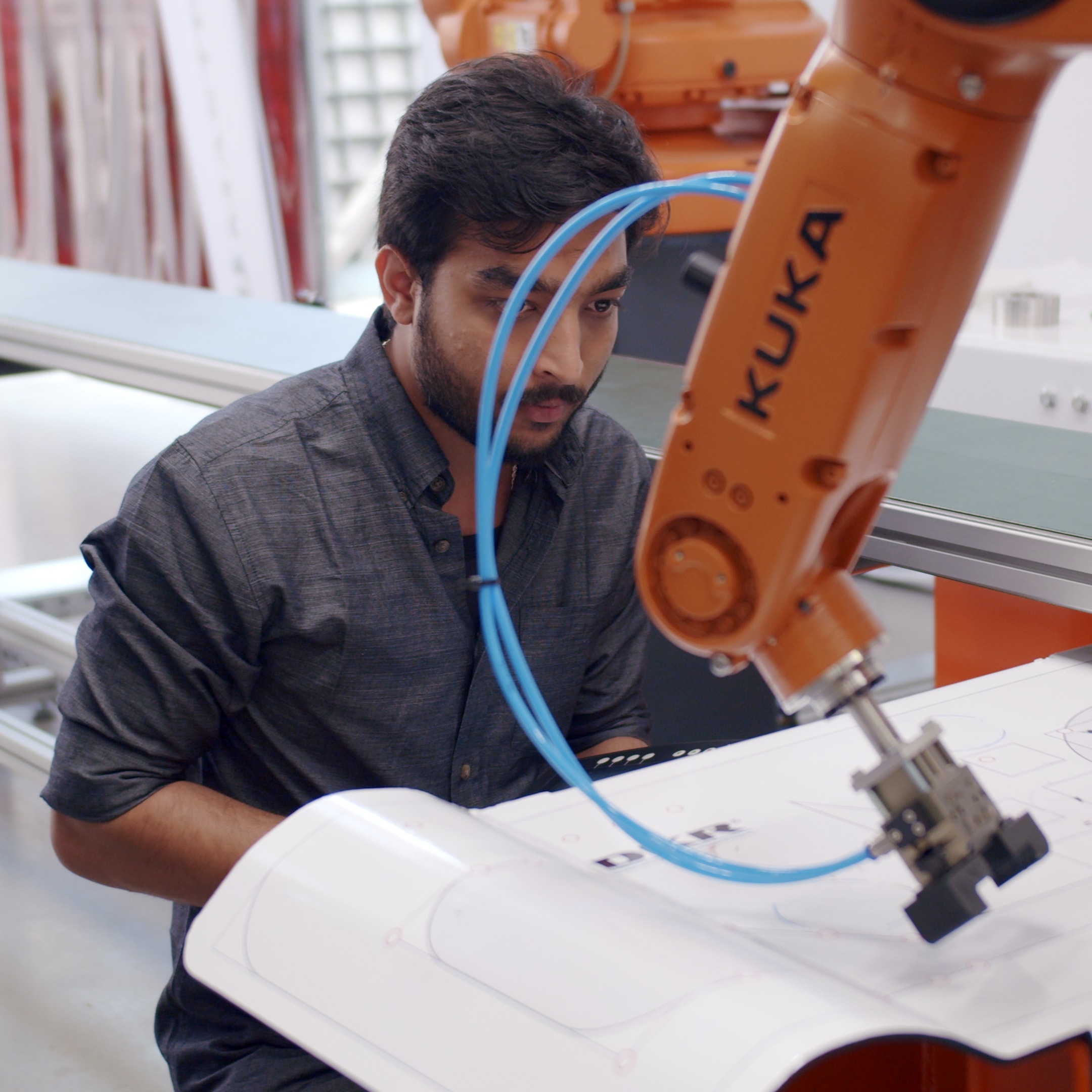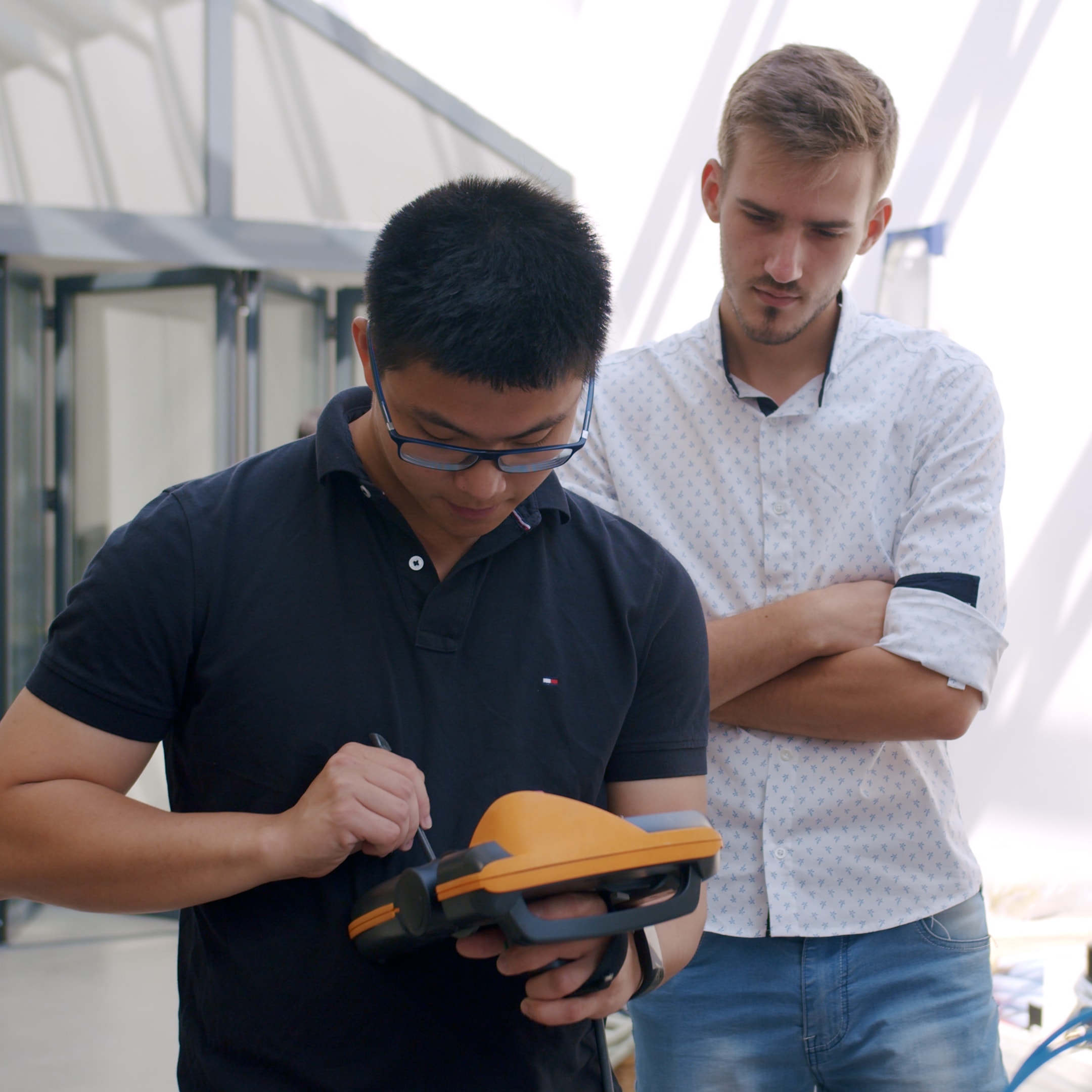Be the best
you can be!
Take your chance and become a certified DKR Robotics Practitioner.
We offer courses for different skill levels to help you to unleash your potential!

Hands-on training
in robotics and
automation
We offer the benefits of world leading German industrial robotics and automation expertise for international student groups for a fraction of the price. We offer a unique program where you can learn industrial robotics and automation programming and operation while developing crucial enterprise skills, making you highly employable.
In addition, the training offers opportunities to see and feel breathtaking nature and get to known the friendly people and welcoming culture of the people in Bosina and Herzegovina. Mingle with automotive industry experts, and listen to their success stories. Experience firsthand industry 4.0 and learn how to utilize it to create a brighter future.
Choose your course:
Course - Robot programming Basic KUKA/ABB/FANUC
Description:
You will learn the basic knowledge of robot programming and will be able to create, save and change simple programs on your own. You will get an overview of the use of industrial robots. You could be taught on KUKA, FANUC or ABB robots.
You will then deepen your programming knowledge and apply complex program structures and communication with PLCs, sensors and actuators. You can train on KUKA, FANUC or ABB robots.
Duration: 16h
Content:
- Safety instructions
- System Description
- Activation and shutdown of the program
- Jogging a robot with a joystick
- Routine & Modules
- Basic instructions
- Error codes
- Basic theory of programming RAPID
- Tool calibration
- Calibration of working objects
- Program Editing
Course - Robot programming ABB ADVANCED
Description:
The aim of the PRO course is to update the upskilling of knowledge in handling the robot cell, to modify the program, to work in the programming language KRL, to understand the extended instructions and critical programming elements and for the picking intended for the management and maintenance of the robot system.
Duration: 32h
Content:
- Safety instructions
- Data (Rob Target, Joint Target)
- Routine & Modules
- Sequences
- External TCP
- World zones
- Advanced functions
- Dispatch
- Trigger statements
- Trap routines
- Work facilities
- Malfunctions
- Definition of TCP & orientation via routines
- Use logical functions in the robot program
- Flex Pendant Communication
- Robot Studio
Course - Robot programming KUKA Advanced
Description:
The aim of the PRO course is to update the upskilling of knowledge in handling the robot cell, to modify the program, to work in the programming language KRL, to understand the extended instructions and critical programming elements and for the picking intended for the management and maintenance of the robot system.
Duration: 32h
Content:
- Safety instructions
- Data
- Basics of successful programming
- Checking the execution of the program
- External TCP
- Data types
- Overview
- Types of Structures
- Sequences
- Logical statements
- Movement programming
- Geometric operators
- Trigger statements
- Subroutines and Functions
- Switching commands
Course - Transfer course
Description:
Transfer courses are designed for professionals who already have experience in programming industrial robots and want to acquire skills in programming and handling another control system.
Duration: 24h
Content:
- Safety instructions
- System Description
- Starting and stopping the program
- Jogging a robot with a joystick
- Tool calibration
- Program editing
- Error codes
KUKA:
- The basic theory of KRL programming
- Calibration of the base
- Checking the execution of the program
- Calibration
- Fundamentals of the KRL programming language
- Subroutines and functions
ABB:
- The basic theory of RAPID programming
- Robot Studio
- Working with U / I signals
- Additional instructions and functions
Robot ProfiNet - configuration with Fieldbus
Description:
The course is designed for candidates who have some knowledge of robotics and related fields, and candidates who want to build their knowledge of digital communication. The course includes theoretical and practical lessons where you can learn the basics of managing complex industrial systems and using PLCs to manage management components.
You will get to know the interaction of robots and fieldbus participants and apply it in practice. You will apply the integration of components using specific project software such as Works Visual, Robot Studio and Robo Guide.
Duration: 40h
Content:
- Safety instructions
- Description of the system
- Starting and stopping the program
- Customize and change the program
- Adjustment
- Inline forms of the KRL movement
- Tool Calibration
- Base calibration
- Program Editing
- Creating a KRC4 project
- Structure of the PROFINET driver KRC4
- Working in TIA PORTAL V13
- Programming self-adjusting KUKA CELL.SRC
Course - TIA Basic
Description:
Future PLC programmers who have little or no previous knowledge of PLC programming in the TIA Portal will learn the basics of TIA Portal programming. You will learn the process of developing simple projects, from the hardware level to the creation of user interfaces on HMI screens using example macros.
This lays the foundation for your future career as a PLC programmer.
Duration: 16 hours
Content:
- introduction to the basics of the TIA portal
- navigation through the TIA portal
- Automation pyramid
- Data Types
- programming languages
- Program modules
- Simple functions in the TIA Portal
- project engineering of PLC programs
- Project Creation
- Use of the “Siemens Proneta” software tool
- Hardware creation
- Software development
- project engineering of HMI panels
- Integration HMI – SPS
- use of basic image building blocks
- Use of visualization effects
- further functions of the TIA portal
- Program simulation with PLC SIM
- observation and forcetables
- Traces
Course - TIA Advanced - HMI
Description:
As a PLC programmer in the industry, you are expected not only to have sufficient knowledge of PLC programming, but also to have no difficulty in developing more complex HMI systems. To further develop your skills as an HMI programmer, we offer the course TIA Advanced – HMI. The focus here is on the creation and generation of error messages and warnings, programming of user-defined image blocks and a brief introduction to Visual Basic programming.
Duration: 60 hours
Content:
- extended HMI functions
- User administration
- error messages and warnings
- User-defined screen modules
- 2nd Introduction to Visual Basic
Course - TIA Safety
Description:
In this course we will teach you the project planning, programming, commissioning, diagnosis and troubleshooting of the fail-safe SIMATIC controllers and the fail-safe, decentralized ET 200 systems. Using practical exercises on a training device, you will learn to put your theoretical knowledge into practice with the STEP 7 Safety software in the TIA Portal.
Duration: 24 hours
Content:
- safety in automation technology
- basics of fail-safe programming
- Fail-safe CPUs
- Fail-safe peripherals Parameters
- Components for fail-safe programming
- F-IO Device
- programming of fail-safe objects
- Safety doors
- Compressed air feeds
Course - TIA Advanced
Description:
You can deepen your theoretical knowledge with numerous practical exercises on a TIA system model. This consists of a SIMATIC S7-1500 automation system, ET 200SP distributed I/O, Touchpanel TP700, drive SINAMICS G120 and a belt model.
Duration: 40 hours
Content:
- IO-Link
- Introduction to the world of IO-Links
- Interface setting with S7-PCT Tool
- RF200 RFID Sample Project
- Sinamics
- identity systems
- Technology Objects
- Ident Blocks
- Ident Profiles
- MV540 sample project
Course - CNC milling machine operator
DESCRIPTION:
This training is intended solely for self-handling and service of the 3-axle CNC machine, without programming methods. The course consists of 40h classes on the modern FANUC Robodrill Α-D21MiA5 CNC machine.
Duration: 40h
Content:
- Programming with G, M codes,
- Using simulator and introduction to SOLIDCAM,
- Generating the G code,
- Introduction to the machine and setting up a coordinate system,
- Working space preparation and safety,
- Selecting, setting up, tightening tool, and recording tool height,
- Switching G code to machine and other servicing.
Course - CNC programmer
Description:
Computer Numerical Control (CNC) courses teach students how to set-up, maintain, operate and dismantle machining tools that are controlled by computers. The candidates will be taught on Fanuc ROBODRILL α-DiB5 series, high-performance vertical machining center.
Duration: 100 hours
Content:
- Basic principles of serving CNC machine
- Introduction in cutting tools, setting them and their offset up in CNC machine
- Standard G, M, T code functions in CNC programming
- Fundamentals of standard CNC program
- Manual programming of CNC machines
- Simulation of CNC program’s for parts on machine or using CAM software
- Practical excercise of programming and making part’s on CNC machine
Customer-specific qualification measures
Description:
We adapt all offered courses specifically to the concrete needs. Together with our customers we work out wishes and needs in a project-oriented way.
Content:
- Qualification within the scope of major projects or production start-ups
- Individual customer-specific employee qualification
Special Courses – Mechatronic Workshop
Description:
DKR is providing a project “Mechatronic Workshop” where the aim is to train young people, students and high school students, as well as employed and unemployed persons to diagnose, maintain, and service industrial robots.

PRACTICE MAKES PERFECT
– that’s our motto.
Our participants are keeping up with the rapid development in robotics and gain a higher level of professionalism.
Participants become certified robot commissioning engineers, programmers and PLC programmers.
We train international professionals, students and employees of emerging companies. Our participants know that education and training are the best investments in the future. Our Programs have been developed step by step based on concrete needs and have real relevance to the modern working world.
